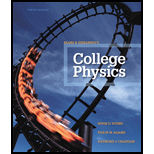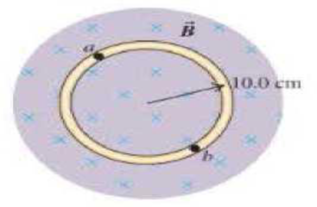
College Physics (10th Edition)
10th Edition
ISBN: 9780321902788
Author: Hugh D. Young, Philip W. Adams, Raymond Joseph Chastain
Publisher: PEARSON
expand_more
expand_more
format_list_bulleted
Concept explainers
Textbook Question
Chapter 21, Problem 12P
A circular loop of wire is in a soalially uniform magnetic field, as shown in Figure 21.46. The magnetic field is directed into the plane of the figure. Determine the direction (clockwise or counterclockwise) of the induced current in the loop when (a) B is increasing; (b) B is decreasing; (c) B is constant with a value of Bn. Explain your reasoning.

Figure 21.48
Problem 12.
Expert Solution & Answer
Want to see the full answer?
Check out a sample textbook solution
Students have asked these similar questions
2
3
Imagine you are out for a stroll on a sunny day when you encounter a lake. Unpolarized light from the sun is reflected off the lake into your eyes. However, you notice when you put on your vertically polarized sunglasses, the light reflected off the lake no longer reaches your eyes. What is the angle between the unpolarized light and the surface of the water, in degrees, measured from the horizontal? You may assume the index of refraction of air is nair=1 and the index of refraction of water is nwater=1.33 . Round your answer to three significant figures. Just enter the number, nothing else.
Chapter 21 Solutions
College Physics (10th Edition)
Ch. 21 - Prob. 1CQCh. 21 - Suppose you drop a cylindrical magnet down a long,...Ch. 21 - A long, straight current-carrying wire passes...Ch. 21 - Two closely wound circular coils have the same...Ch. 21 - Prob. 5CQCh. 21 - Why does a transformer not work with dc current?Ch. 21 - Does Lenzs law say that the induced current in a...Ch. 21 - Does Faradays law say that a large magnetic flux...Ch. 21 - An airplane is in level flight over Antarctica,...Ch. 21 - Prob. 10CQ
Ch. 21 - A metal ring can be moved into and out of the...Ch. 21 - Prob. 12CQCh. 21 - A square loop of wire is pulled upward out of the...Ch. 21 - The two solenoids in Figure 21.36 are coaxial and...Ch. 21 - A metal ring is oriented with the plane of its...Ch. 21 - Prob. 4MCPCh. 21 - A metal loop moves at constant velocity toward a...Ch. 21 - A steady current of 1.5 A flows through the...Ch. 21 - Suppose you continue to hold the current in the...Ch. 21 - A vertical bar moves horizontally at constant...Ch. 21 - The vertical loops A and C in Figure 21.41 e are...Ch. 21 - The vertical loops A and C in Figure 21.41 e are...Ch. 21 - After the switch S in the circuit in Figure 21.42...Ch. 21 - A metal loop is being pushed at a constant...Ch. 21 - A circular area with a radius of 6.50 cm lies in...Ch. 21 - Prob. 2PCh. 21 - An empty cylindrical food container with a lid on...Ch. 21 - A single loop of wire with an area of 0.0900 m2 is...Ch. 21 - A coil of wire with 200 circular turns of radius...Ch. 21 - In a physics laboratory experiment, a coil with...Ch. 21 - A closely wound rectangular coil of 80 turns has...Ch. 21 - Prob. 8PCh. 21 - Prob. 9PCh. 21 - A circular loop of wire a radius of 12.0 cm is...Ch. 21 - A cardboard tube is wrapped with windings of...Ch. 21 - A circular loop of wire is in a soalially uniform...Ch. 21 - Prob. 13PCh. 21 - A solenoid carrying a current i is moving toward a...Ch. 21 - A metal bar is pulled to the right perpendicular...Ch. 21 - Two closed loops A and C are close to a long wire...Ch. 21 - A bar magnet is held above a circular loop of wire...Ch. 21 - The current in Figure 21.54 obeys the equation I =...Ch. 21 - A bar magnet is close to a metal loop. When this...Ch. 21 - A very thin 15.0 cm copper bar is aligned...Ch. 21 - When a thin 12.0 cm iron rod moves with a constant...Ch. 21 - You wish to produce a potential difference of 10 V...Ch. 21 - A 1.41 m bar moves through a uniform, 1.20 T...Ch. 21 - The conducting rod ab shown in Figure 21.58 makes...Ch. 21 - BO Measuring blood flow. Blood contains positive...Ch. 21 - Prob. 26PCh. 21 - Prob. 27PCh. 21 - Prob. 28PCh. 21 - Prob. 29PCh. 21 - Prob. 30PCh. 21 - Prob. 31PCh. 21 - Prob. 32PCh. 21 - Prob. 33PCh. 21 - Prob. 34PCh. 21 - Prob. 35PCh. 21 - A transformer consists of 275 primary windings and...Ch. 21 - You need a transformer that will draw 15 W of...Ch. 21 - A step-up transformer. A transformer connected to...Ch. 21 - Prob. 39PCh. 21 - Prob. 40PCh. 21 - Prob. 41PCh. 21 - A solenoid 25.0 cm long and with a cross-sectional...Ch. 21 - Prob. 43PCh. 21 - Prob. 44PCh. 21 - Prob. 45PCh. 21 - Prob. 46PCh. 21 - Prob. 47PCh. 21 - Prob. 48PCh. 21 - Prob. 49PCh. 21 - A 12.0 F capacitor and a 5.25 mH inductor are...Ch. 21 - Prob. 51PCh. 21 - A 15.0 F capacitor is charged to 175 C and then...Ch. 21 - Prob. 53GPCh. 21 - A rectangular circuit is moved at a constant...Ch. 21 - Prob. 55GPCh. 21 - A flexible circular loop 6.50 cm in diameter lies...Ch. 21 - Prob. 57GPCh. 21 - Prob. 58GPCh. 21 - Consider the circuit in Figure 21.64 (a) Just...Ch. 21 - How many turns does this typical MRI magnet have?...Ch. 21 - BIO Quenching an MRI magnet. Magnets carrying very...Ch. 21 - If part of the magnet develops resistance and...Ch. 21 - BIO Quenching an MRI magnet. Magnets carrying very...Ch. 21 - Prob. 64PPCh. 21 - Consider the brain tissue at the level of the...Ch. 21 - Prob. 66PPCh. 21 - Which graph best represents the time t dependence...
Additional Science Textbook Solutions
Find more solutions based on key concepts
27. Consider the reaction.
Express the rate of the reaction in terms of the change in concentration of each of...
Chemistry: Structure and Properties (2nd Edition)
The accompanying chromosome diagram represents a eukaryotic chromosome prepared with Giemsa stain. Indicate the...
Genetic Analysis: An Integrated Approach (3rd Edition)
Carefully examine the common sedimentary rocks shown In Figure 2.13. Use these photos and the preceding discuss...
Applications and Investigations in Earth Science (9th Edition)
explain the function of fermentation and the conditions under which it occurs?
Biology: Life on Earth with Physiology (11th Edition)
The number of named species is about __________, but the actual number of species on Earth is estimated to be a...
Biology: Life on Earth (11th Edition)
Community 1 contains 100 individuals distributed among four species: 5A, 5B, 85C, and 5D Community 2 contains 1...
Campbell Biology in Focus (2nd Edition)
Knowledge Booster
Learn more about
Need a deep-dive on the concept behind this application? Look no further. Learn more about this topic, physics and related others by exploring similar questions and additional content below.Similar questions
- 20. Two small conducting spheres are placed on top of insulating pads. The 3.7 × 10-10 C sphere is fixed whie the 3.0 × 107 C sphere, initially at rest, is free to move. The mass of each sphere is 0.09 kg. If the spheres are initially 0.10 m apart, how fast will the sphere be moving when they are 1.5 m apart?arrow_forwardpls help on allarrow_forwardpls help on thesearrow_forward
- pls help on all asked questions kindlyarrow_forwardpls help on all asked questions kindlyarrow_forward19. Mount Everest, Earth's highest mountain above sea level, has a peak of 8849 m above sea level. Assume that sea level defines the height of Earth's surface. (re = 6.38 × 106 m, ME = 5.98 × 1024 kg, G = 6.67 × 10 -11 Nm²/kg²) a. Calculate the strength of Earth's gravitational field at a point at the peak of Mount Everest. b. What is the ratio of the strength of Earth's gravitational field at a point 644416m below the surface of the Earth to a point at the top of Mount Everest? C. A tourist watching the sunrise on top of Mount Everest observes a satellite orbiting Earth at an altitude 3580 km above his position. Determine the speed of the satellite.arrow_forward
- pls help on allarrow_forwardpls help on allarrow_forward6. As the distance between two charges decreases, the magnitude of the electric potential energy of the two-charge system: a) Always increases b) Always decreases c) Increases if the charges have the same sign, decreases if they have the opposite signs d) Increases if the charges have the opposite sign, decreases if they have the same sign 7. To analyze the motion of an elastic collision between two charged particles we use conservation of & a) Energy, Velocity b) Momentum, Force c) Mass, Momentum d) Energy, Momentum e) Kinetic Energy, Potential Energyarrow_forward
arrow_back_ios
SEE MORE QUESTIONS
arrow_forward_ios
Recommended textbooks for you

 Physics for Scientists and Engineers: Foundations...PhysicsISBN:9781133939146Author:Katz, Debora M.Publisher:Cengage Learning
Physics for Scientists and Engineers: Foundations...PhysicsISBN:9781133939146Author:Katz, Debora M.Publisher:Cengage Learning Physics for Scientists and Engineers with Modern ...PhysicsISBN:9781337553292Author:Raymond A. Serway, John W. JewettPublisher:Cengage Learning
Physics for Scientists and Engineers with Modern ...PhysicsISBN:9781337553292Author:Raymond A. Serway, John W. JewettPublisher:Cengage Learning Principles of Physics: A Calculus-Based TextPhysicsISBN:9781133104261Author:Raymond A. Serway, John W. JewettPublisher:Cengage Learning
Principles of Physics: A Calculus-Based TextPhysicsISBN:9781133104261Author:Raymond A. Serway, John W. JewettPublisher:Cengage Learning Physics for Scientists and EngineersPhysicsISBN:9781337553278Author:Raymond A. Serway, John W. JewettPublisher:Cengage Learning
Physics for Scientists and EngineersPhysicsISBN:9781337553278Author:Raymond A. Serway, John W. JewettPublisher:Cengage Learning College PhysicsPhysicsISBN:9781305952300Author:Raymond A. Serway, Chris VuillePublisher:Cengage Learning
College PhysicsPhysicsISBN:9781305952300Author:Raymond A. Serway, Chris VuillePublisher:Cengage Learning


Physics for Scientists and Engineers: Foundations...
Physics
ISBN:9781133939146
Author:Katz, Debora M.
Publisher:Cengage Learning

Physics for Scientists and Engineers with Modern ...
Physics
ISBN:9781337553292
Author:Raymond A. Serway, John W. Jewett
Publisher:Cengage Learning

Principles of Physics: A Calculus-Based Text
Physics
ISBN:9781133104261
Author:Raymond A. Serway, John W. Jewett
Publisher:Cengage Learning

Physics for Scientists and Engineers
Physics
ISBN:9781337553278
Author:Raymond A. Serway, John W. Jewett
Publisher:Cengage Learning

College Physics
Physics
ISBN:9781305952300
Author:Raymond A. Serway, Chris Vuille
Publisher:Cengage Learning
Magnets and Magnetic Fields; Author: Professor Dave explains;https://www.youtube.com/watch?v=IgtIdttfGVw;License: Standard YouTube License, CC-BY